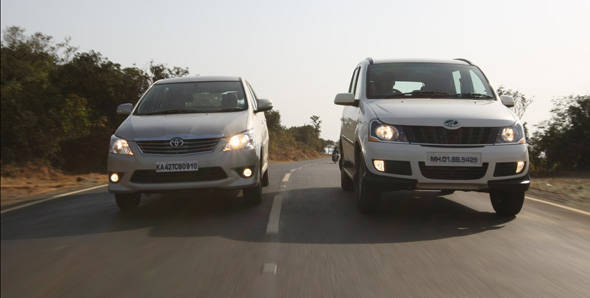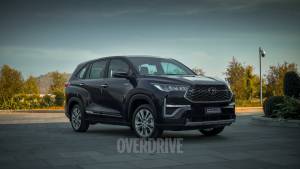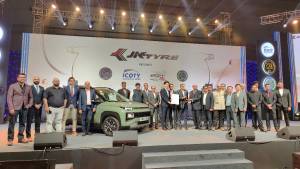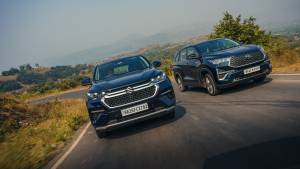2012 Toyota Innova vs Mahindra Xylo E9

After having being perched comfortably on the pedestal for a long time, having easily brushed away the challenge from those trying to usurp the crown, you are allowed to feel invincible. That's where the Toyota Innova is currently at. It has been seven years since its launch and it's still selling like hot cakes commanding a six-month waiting period at most dealers. And interestingly it's also one of those vehicles that despite being the favourite among the fleet taxi crowd has also managed to establish its space among the private owners. And just when there were these hushed whispers of 'it's getting too long in the tooth', Toyota gave it a refresh. A 'bring it' to its competition.
But now there's a challenger who has taken the bit between its teeth. The Mahindra Xylo, when it was launched in January 2009, did turn heads but for all the wrong reasons. The front fascia was plain ugly and everyone was left wondering why it has an 'upturned pig nose' expression. Three years down the line Mahindra decided to put the Xylo under the knife and the result is a refreshing change and this time people are giving it a second look for all the right reasons. Now the old Xylo, despite its looks, has been a success story for Mahindra raking in the numbers. But it has always been second best when compared to the Innova. So does the new Xylo have the beans to take on India's favourite people mover?
Design
Refresh and revitalize. That seems to be the mantra with most manufacturers these days. Even the most loyal customer has a roving eye, especially with the many options available, and so everyone is going the nip and tuck way to keep the buyer interested.
And which is why Toyota decided to give the Innova a refresh. The front fascia has undergone a complete makeover with the new headlamps design, now angular, trapezoidal and no longer curvy, tear drop like. It also extends further past the bonnet line than before giving the front a wider look. The front grille now gets three horizontal slats instead of the two before. The air dam shape too has been changed with the earlier parallelogram design now being flipped vertically. All of this gives the front a lower stance than before. At the rear the only change is the tail lamp design with the indicator lamps now being housed in the middle of the cluster unlike at the bottom in the earlier version. From the side there are no changes except that the rear view mirrors now get turn indicators. So on the whole, the new Innova maintains its utilitarian design but the refresh now makes it look sleeker and more car-like.
The refresh on the Xylo, though just cosmetic, looks much more extreme but in a positive way. The obnoxious front grille has been hammered into place and what we now get is a much more pleasing rectangular grille with the Mahindra logo now resting cleanly on the restyled bonnet rather than on the grille as in the previous version. The clear lens headlamps add to the sleek new look. The front bumper has also been reworked and it now gets a black plastic extension and so do the wheel arches which are now more pronounced. From the side the floating roof looks good with the blackened B,C and D pillars but the thick black stickering on the D pillar looks like an afterthought. But on the whole the new Xylo now looks more polished, and needless to say, much more appealing than the earlier version.
Head to head, then. Both of them have a minimalistic design approach but the Xylo because of its taller stance looks shorter and wider than the Innova though it's actually longer and is only 45mm less wide. The more pronounced cab forward design in the Innova also gives it a more streamlined look as compared to the Xylo. Another factor that swings it towards the Innova is the tailgate which doesn't swing but instead opens upwards allowing for easier loading of the boot. So refresh to refresh, while the Xylo has managed to clean up the front it's still the Innova with its clean design that walks away the winner.
Interiors
Let's take it inside then. The Innova in its refresh hasn't changed too much. But the centre console now gets brushed aluminium surrounds instead of the mock wood before and that makes it look more premium. The Corolla steering wheel now finds its way into the Innova with steering-mounted audio and mobile phone controls available in the higher variants. The fonts in the clocks have also been changed. The dual tone beige finish on the dashboard and the seats are still the same.
As compared to this the Xylo interiors feel plush when you see it first. The E9 variant which we tested came with brown Italian leather upholstery which gives it a premium feel. The wood finish surrounds on the centre console and the doors add to this effect. The centre console now also has a display for the trip computer. The hard to use gear lever has now been replaced with a more easy to hold rounded design. A really interesting feature is the new voice command system which can be accessed with a button on the steering wheel. Using this feature you can lock and unlock doors, operate wipers, headlamps and many other features. You can't use it to operate your windows though. Erm, it even has a 'live chat' option. Say 'Hi' and you get a response "Hi, I am fine thank you. How (sounds like hawf) about you(f)self." After a pause of about five seconds it continues "Ok. You have a nice time. Thank you." And it understands Indian accent.
But after you have spent some time in both vehicles you start to appreciate the easy design of the Innova's cabin and the thought process put into it. The buttons on the steering wheel for instance follow the contour of your hand and feels like it's in the right place unlike the ones on the Xylo which feel like a last minute addition. The steering wheel itself is much better to grip at than that of its competitor. In terms of storage space the two are evenly matched except the Xylo gets flip-up tables mounted behind the front seats. The space inside the Xylo is also more and each seat also gets armrests. But the brown interiors makes that space seem less and that's where you realise the clever benefit of using beige, like in the Innova. So overall, when you enter the vehicle the first time you lean towards the Xylo's interiors but when you step out of it, after having spend some time, you will have comprehensively decided in favour of the Innova's.
Performance & efficiency
This is where the battle gets interesting. Toyota hasn't upgraded the engine in its refresh. It's still the same 2.5-litre diesel mill that rests under the Innova's hood. It produces a maximum power of 102PS at 3600rpm and a maximum torque of 200Nm which is available from 1400-3400rpm. The Xylo on the other hand now sports a mHawk engine borrowed from the Scorpio in its E9 variant. This engine produces 120PS of power at 4000rpm and 280Nm of torque between 2400-2800rpm. This simply translates into the E9 having a more powerful and torquier engine. On the highway this is evidently clear with the Innova only being able to see the rear of the Xylo disappear into the distance. The Mahindra goes from 0-100kmph in 13.75 seconds while the Toyota takes 17.69 seconds. Not only is the E9 quicker than the Innova by 4 seconds but it's also two seconds quicker than even the Scorpio.
There is also a difference of 18.5kmph in the top speed with the Innova managing to get to only 150.5kmph. The Innova feels strained once you push it even in its top gear. The Xylo on the other hand feels like you can push it more. In fact even the mEagle engine which is put into service in the lower variants (E4-E8) has better performance figures than that of the Innova (113PS at 3800rpm and 235Nm at 1800-3000rpm). But when you consider the utility of these vehicles then the pedal to the metal factor doesn't come into play.
Those who buy these vehicles simply want to cruise in them and for that purpose the Innova has sufficient power available. While it may be underpowered in the engine department the Innova scores heavily in the transmission department. Even though the long throw gear lever requires more work in clutch and gear play, the Toyota gearbox delivers more precise shifts. And this is a boon in the city as well as on the highway. But the Xylo scores when it comes to the efficiency department. In our tests it returned an overall mileage of 12.5kmpl as compared to the Innova's 11.8kmpl which means it has an additional range of 38km.
Ride quality & handling
It's not for nothing that the Innova is the most preferred people mover. It feels balanced and sturdy. It has a more car-like feel and can carry more speed through corners as compared to the Xylo even though it has less power. The Xylo on the other hand, because of its tall stance, feels bulky and has body roll. It doesn't give you the same confidence as the Innova around corners. That's not to say that the Xylo is a bad handler. It does a good job about it, definitely much better than the Scorpios but just that when compared to the high standards of the Innova it falls behind. Another factor that aids the Innova is its direct steering which keeps the driver in constant touch with the road. The Xylo steering on the other hand has more play. But one of the advantages of the Xylo steering is that being lighter it is helpful at parking speeds which is a boon within the city.
The ride quality on the Xylo is slightly better than that on the Innova because the Mahindra sports wider and higher profile tyres as compared to that on the Toyota. So it comfortably devours the bumps while the Innova, also being slightly stiffly sprung, tends to transfer a bit of the undulations to its occupants. Both the vehicles use a disc and drum combination at the front and rear respectively. Both the MUVs have ABS the E9 and the VX variants but it is still the Innova that comes to a halt quicker and in a shorter distance. The Mahindra takes 3.9 seconds to go from 100-0kmph while using up 52 metres while the Toyota takes only 3.19 seconds and also does it in 43.26 metres.
Verdict
The battles have been fought and now let's decide the outcome of the war. The MPV segment has a very specific customer one that demands more of durability, efficiency, comfort with less emphasis on the 'pedal to the metal' handling abilities. And all of this should be at a competitive price. Straight to that then. The Xylo E9 costs Rs 9.93 lakh while the Innova VX will cost you Rs 13.04 lakh. Both prices ex-showroom, Mumbai. That's a big difference of Rs 3.11 lakh. Or a difference of almost a Hyundai Eon if you may (D-lite, Rs 3.17 lakh, ex-Mumbai). The Xylo, after its refresh, will now definitely appeal to a wider audience. It offers a host of features, the voice command activation being a successful and useful addition. The Mahindra being more frugal also presents a strong case for itself. It has more power, is easier to use in the city because of its light steering and also seats the same number of people as the Innova but in more comfort. So that's it then. A clear winner? Hold your horses.
It's not for nothing that the Innova has been dominating this segment for a long time now. You see when you buy the Innova you get the assured reliability which comes with every Toyota badge. You will be buying a vehicle which is better engineered. With the Innova what also comes as standard fitment is peace of mind. After gathering the miles, the Innova will definitely last longer, something which has been proven over the years, and which in this segment remains a prime criterion. Over a longer period of time the Innova will hold its quality. So while five years later the Toyota will still retain its newness, we doubt the Mahindra will be able to match that. With its refresh the complaint about it being long in the tooth has also been taken care of. The Innova is also ergonomically car-like to drive and it is a safer vehicle than the Xylo. Another crucial factor is the resale value of the Innova. Even in the used car market the Innova is highly in demand, especially from the fleet taxi operators. Because of this demand the price that you get for an Innova, as compared to the Xylo, is much higher.
And it's these trump cards that help the Innova edge out the Xylo in this photo finish. The Xylo will continue to rake in the numbers for Mahindra, in all probability more than before. We also know that the Mahindra with every refresh gets better but for now it's the Toyota that walks away head held high.
Starts Rs 9.42 Lakhs
2489cc
Manual
120
218
14.95 Kmpl
Starts Rs 3.29 Lakhs
814cc
Manual
56
74.5
21.1 Kmpl
Related Stories
Top Stories
Latest Videos
Most Popular
Network18 Updates














